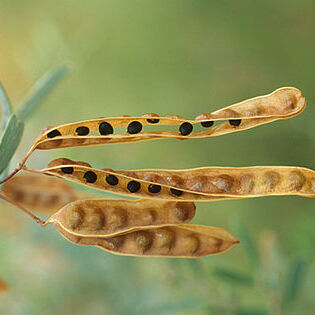Shrub or tree to 5 (–8) m high, commonly suckering and forming colonies. Branchlets often pruinose, glabrous. Phyllodes linear to narrowly elliptic, sometimes oblanceolate, 5–15 (–20) cm long, 1.5–8 (–20) mm wide, with a minute callous ±curved mucro overtopping the gland, thinly coriaceous, often drying finely longitudinally wrinkled, pale green to glaucous, glabrous; midrib not prominent; lateral veins obscure and longitudinally anastomosing; glands basal, and at base of mucro. Inflorescences 2–10-headed racemes; raceme axes 1–6 cm long, slender, glabrous; peduncles 4–10 (–15) mm long, slender, glabrous; heads globular, densely 25–50-flowered, light golden to mid-golden. Flowers 5-merous; sepals ±free. Pods narrowly oblong, prominently rounded over seeds, to 9 cm long, 8–12 mm wide, chartaceous, sometimes pruinose, glabrous. Seeds transverse to oblique, oblong, elliptic, ovate or ±orbicular, 4–5.5 mm long, shallowly depressed at centre, dull, black, exarillate.
More
It is a bushy shrub. It grows 2-5 m tall. The trunk is slender and the bark is pinkish or white. The bark is smooth. The crown is spreading. The branches are angular in cross section. They are yellowish green to reddish brown. The leaves (phyllodes) are pale green or blue green. They are flat and thick. The edges are yellowish. They are 5-18 cm long by 0.2-0.7 cm wide. Leaf size and shape varies. The tip is blunt but with a small re-curved point. The flowers are bright yellow balls. They are 7-9 mm across. They form open branched bunches. The pods are light brown. They are papery. They are up to 5-7 cm long and 1 cm wide. They are raised over the seeds and constricted between the seeds. This means each seed is clearly defined. The seeds are black. They are quite large and have a quite hard thick coat.
A relatively poor stock fodder plant. Details of the utilisation of Acacia murrayana are given in J.W. Turnbull (ed.), Multipurpose Australian Trees & Shrubs 170–173 (1986), J.C. Doran et al., in J.C. Doran & J.W. Turnbull (eds), Australian Trees and Shrubs: Species for Land Rehabilitation and Farm Planting in the Tropics 190–191 (1997), B.R. Maslin & M.W. McDonald, AcaciaSearch: Evaluation of Acacia as a woody crop option for southern Australia, pp. 142–147, RIRDC Publication No 03/017 (2006), and B.R. Maslin et al., Wattles of the Pilbara (2010).
More
The seeds are softened by soaking in water, pounded to a paste then eaten raw. They can also be eaten green after roasting in the pod. An edible grub occurs in the roots and branches. The white gum is eaten. The mature seeds have also been roasted and ground as a coffee substitute.


